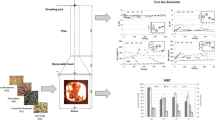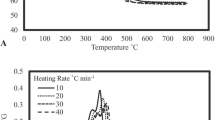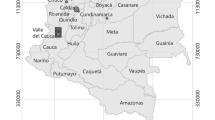Abstract
This study assesses whether the use of Tessaria absinthioides (TA) pellets as a bioenergy resource is feasible or not. Its fuel properties were characterized and its combustion behavior assessed via a traditional log wood stove with a basket of wood pellets. Combustion of pinewood (Pinus radiata) commercial pellets (CP) was used as a reference in order to analyze experimental results. TA has a high ash content of 8.1% and an HHV of 17.47 MJ kg−1. Alkaline index on the TA pellets was of 1.46 kg alkali GJ−1, a relatively high value, which resulted from high sodium content in ash. Oven and exhaust temperatures during the combustion of TA and CP present similar behavior. The combustion chamber’s highest temperature for CP was 841.15 °C, while for TA, the highest temperature was 685.65 °C. Furthermore, CO and PM emission was superior for TA pellets, averaging about 4943.6 ± 235.2 mg Nm−3 and 32.45 ± 6.49 mg MJ−1, respectively at 13% O2. Results obtained have shown that there were no apparent hindrances for an extensive use of TA as a bioenergy resource and use of pellet baskets to combust pellets in traditional wood log stoves.
Graphical Abstract







Similar content being viewed by others
Data Availability
Datasets generated and analyzed during the current study are available from the corresponding author upon a reasonable request.
References
Pimentel D (2001) Economic and environmental impacts of invasive species and their management. Pestic You 21:10–11
Adeux G, Vieren E, Carlesi S et al (2019) Mitigating crop yield losses through weed diversity. Nat Sustain 2:1018–1026. https://doi.org/10.1038/s41893-019-0415-y
Matloob A, Ehsan Safdar M, Abbas T et al (2020) Challenges and prospects for weed management in Pakistan: a review. Crop Prot 134:104724. https://doi.org/10.1016/j.cropro.2019.01.030
Yang Z, Liu Y, Bao G et al (2006) Rehabilitation and sustainable use pattern of rocky-desertified land in Southwest China’s poverty-stricken karst mountainous areas. J Mt Sci 3:237–246. https://doi.org/10.1007/s11629-006-0237-z
Ternelli M, Brighenti V, Anceschi L et al (2020) Innovative methods for the preparation of medical Cannabis oils with a high content of both cannabinoids and terpenes. J Pharm Biomed Anal 186:113296. https://doi.org/10.1016/j.jpba.2020.113296
Ma J, Feng X, Yang X et al (2020) The leaf extract of crofton weed (Eupatorium adenophorum) inhibits primary root growth by inducing cell death in maize root border cells. Plant Divers 42:174–180. https://doi.org/10.1016/j.pld.2020.02.001
Kamaraj M, Srinivasan NR, Assefa G et al (2020) Facile development of sunlit ZnO nanoparticles-activated carbon hybrid from pernicious weed as an operative nano-adsorbent for removal of methylene blue and chromium from aqueous solution: extended application in tannery industrial wastewater. Environ Technol Innov 17:100540. https://doi.org/10.1016/j.eti.2019.100540
Saini VK, Suthar S, Karmveer C, Kumar K (2017) Valorization of toxic weed Lantana camara L. biomass for adsorptive removal of lead. J Chem 2017:1–12. https://doi.org/10.1155/2017/5612594
Olugbade TO, Ojo OT (2020) Biomass torrefaction for the production of high-grade solid biofuels: a review. BioEnergy Res 13:999–1015. https://doi.org/10.1007/s12155-020-10138-3
Atkinson CJ (2009) Establishing perennial grass energy crops in the UK: a review of current propagation options for Miscanthus. Biomass Bioenergy 33:752–759. https://doi.org/10.1016/j.biombioe.2009.01.005
Scordia D, Cosentino S (2019) Perennial Energy grasses: resilient crops in a changing European agriculture. Agriculture 9:169. https://doi.org/10.3390/agriculture9080169
Torres-Carro R, Isla MI, Thomas-Valdes S et al (2017) Inhibition of pro-inflammatory enzymes by medicinal plants from the Argentinean highlands (Puna). J Ethnopharmacol 205:57–68. https://doi.org/10.1016/j.jep.2017.04.013
Persia FA, Rinaldini E, Carrión A et al (2017) Evaluation of cytotoxic and antitumoral properties of Tessaria absinthioides (Hook & Arn) dc, “Pájaro Bobo”, aqueous extract. Medicine (B Aires) 77:1–15
ENplus (2015) Part 2-Quality certification scheme for wood pellets. In: ENplus Handbook, 3rd edn. European Pellet Council (EPC), Brussels, pp 1–50
ENplus (2011) Part 2: Certification procedure. In: ENplus handbook (UK Pellet Council-Handbook). European Pellet Council (EPC), London, pp 1–49
ISO-ISO/TC-238 ISO - ISO/TC 238 - Solid biofuels. https://www.iso.org/committee/554401/x/catalogue/. Accessed 31 Dec 2019
Sluiter JB, Ruiz RO, Scarlata CJ et al (2010) Compositional analysis of lignocellulosic feedstocks. Review and description of methods. J Agric Food Chem 58:9043–9053. https://doi.org/10.1021/jf1008023
Wunderlich B (2001) Thermal Analysis. In: Buschow KHJ, Flemings MC (eds) Encyclopedia of materials: science and technology, 1st edn. Elsevier, Amsterdam, pp 9134–9141
Yesilkir-Baydar S, Oztel ON, Cakir-Koc R, Candayan A (2017) Chapter 11: Evaluation techniques. In: Razavi M, Thakor A (eds) Nanobiomaterials science, development and evaluation. Woodhead Publishing, Duxford, pp 211–232
Jenkins B, Baxter L, Miles T, Miles T (1998) Combustion properties of biomass. Fuel Process Technol 54:17–46. https://doi.org/10.1016/S0378-3820(97)00059-3
Miles TR, Baxter LL, Bryers RW et al (1995) Boilers. Fuels and deposit formation. In: Alkali deposits found in biomass power plants, vol 1, 1st edn. National Techrucd Momation Service (NTIS), Golden, pp 1–122
Pedroso DT, Kaltschmitt M (2012) Dichrostachys cinerea as a possible energy crop—facts and figures. Biomass Convers Biorefin 2:41–51. https://doi.org/10.1007/s13399-011-0026-y
Bain RL, Overend RP, Craig KR (1998) Biomass-fired power generation. Fuel Process Technol 54:1–16. https://doi.org/10.1016/S0378-3820(97)00058-1
Demirbas A (2005) Potential applications of renewable energy sources, biomass combustion problems in boiler power systems and combustion related environmental issues. Prog Energy Combust Sci 31:171–192
Jenkins BM, Jones AD, Turn SQ, Williams RB (1996) Particle concentrations, gas-particle partitioning, and species intercorrelations for polycyclic aromatic hydrocarbons (PAH) emitted during biomass burning. Atmos Environ 30:3825–3835. https://doi.org/10.1016/1352-2310(96)00084-2
Jimenez J, Farias O, Quiroz R, Yañez J (2017) Emission factors of particulate matter, polycyclic aromatic hydrocarbons, and levoglucosan from wood combustion in south-central Chile. J Air Waste Manage Assoc 67:806–813. https://doi.org/10.1080/10962247.2017.1295114
Agency USEP (2017) Method 5G - Determination of particulate matter emissions from wood heaters (dilution tunnel sampling location). Patent Fed Regist 65:61867–61877
Arteaga-Pérez LE, Segura C, Espinoza D et al (2015) Torrefaction of Pinus radiata and Eucalyptus globulus: a combined experimental and modeling approach to process synthesis. Energy Sustain Dev 29:13–23. https://doi.org/10.1016/j.esd.2015.08.004
Joly D, Santoro CM, Gayo EM et al (2017) Late pleistocene fuel management and human colonization of the Atacama desert, northern Chile. Lat Am Antiq 28:144–160. https://doi.org/10.1017/laq.2016.8
Williams CL, Emerson RM, Tumuluru JS (2017) Biomass compositional analysis for conversion to renewable fuels and chemicals. In: Tumuluru JS (ed) Biomass volume estimation and valorization for energy, 1st edn. InTech, London, pp 1–21
Cavalaglio G, Cotana F, Nicolini A et al (2020) Characterization of various biomass feedstock suitable for small-scale energy plants as preliminary activity of biocheaper project. Sustain 12:2–20. https://doi.org/10.3390/su12166678
Zając G, Szyszlak-Bargłowicz J, Gołębiowski W, Szczepanik M (2018) Chemical characteristics of biomass ashes. Energies 11:2885–2900. https://doi.org/10.3390/en11112885
Carvalho L, Wopienka E, Pointner C et al (2013) Performance of a pellet boiler fired with agricultural fuels. Appl Energy 104:286–296. https://doi.org/10.1016/j.apenergy.2012.10.058
Kurina Sanz M, Hernandez XE, Tonn CE, Guerreiro E (2000) Enhancement of tessaric acid production Tessaria absinthioides cell suspension cultures. Plant Cell Rep 19:821–824. https://doi.org/10.1007/s002990000192
Huang J, Zhang J, Liu J et al (2019) Thermal conversion behaviors and products of spent mushroom substrate in CO2 and N2 atmospheres: kinetic, thermodynamic, TG and Py-GC/MS analyses. J Anal Appl Pyrolysis 139:177–186. https://doi.org/10.1016/j.jaap.2019.02.002
Abdelouahed L, Leveneur S, Vernieres-Hassimi L et al (2017) Comparative investigation for the determination of kinetic parameters for biomass pyrolysis by thermogravimetric analysis. J Therm Anal Calorim 129:1201–1213. https://doi.org/10.1007/s10973-017-6212-9
Brachi P, Miccio F, Miccio M, Ruoppolo G (2015) Isoconversional kinetic analysis of olive pomace decomposition under torrefaction operating conditions. Fuel Process Technol 130:147–154. https://doi.org/10.1016/j.fuproc.2014.09.043
Lin Y, Liao Y, Yu Z et al (2017) A study on co-pyrolysis of bagasse and sewage sludge using TG-FTIR and Py-GC/MS. Energy Convers Manag 151:190–198. https://doi.org/10.1016/j.enconman.2017.08.062
Chen Z, Zhu Q, Wang X et al (2015) Pyrolysis behaviors and kinetic studies on Eucalyptus residues using thermogravimetric analysis. Energy Convers Manag 105:251–259. https://doi.org/10.1016/j.enconman.2015.07.077
Marques G, Rencoret J, Gutiérrez A, del Río JC (2014) Evaluation of the chemical composition of different non-woody plant fibers used for pulp and paper manufacturing. Open Agric J 4:93–101. https://doi.org/10.2174/1874331501004010093
Vicente ED, Duarte MA, Tarelho LAC et al (2015) Particulate and gaseous emissions from the combustion of different biofuels in a pellet stove. Atmos Environ 120:15–27. https://doi.org/10.1016/j.atmosenv.2015.08.067
Koppejan J (2012) Environmental aspects of biomass combustion. In: The handbook of biomass combustion and co-firing, 1st edn. Routledge, London, pp 1–442
Itoh T, Fujiwara N, Iwabuchi K et al (2020) Effects of pyrolysis temperature and feedstock type on particulate matter emission characteristics during biochar combustion. Fuel Process Technol 204:106408. https://doi.org/10.1016/j.fuproc.2020.106408
Lamberg H, Tissari J, Jokiniemi J, Sippula O (2013) Fine particle and gaseous emissions from a small-scale boiler fueled by pellets of various raw materials. Energy Fuel 27:7044–7053. https://doi.org/10.1021/ef401267t
Sippula O (2010) Fine particle formation and emissions in biomass combustion. Dissertation. University of Eastern Finland
Carlsson S, Gustavsson L, Johansson M, et al (2018) Measurements of emissions of EC, OC and other pollutants from residential wood combustion in the Nordic countries. Project Report. Nordisk Ministerråd, Copenhagen
Polonini L, Petrocelli D, Parmigiani S, Lezzi A (2019) Influence on CO and PM emissions of an innovative burner pot for pellet stoves: an experimental study. Energies 12:590. https://doi.org/10.3390/en12040590
Kistler M, Schmidl C, Padouvas E et al (2012) Odor, gaseous and PM 10 emissions from small scale combustion of wood types indigenous to Central Europe. Atmos Environ 51:86–93. https://doi.org/10.1016/j.atmosenv.2012.01.044
Mitchell EJS, Lea-Langton AR, Jones JM et al (2016) The impact of fuel properties on the emissions from the combustion of biomass and other solid fuels in a fixed bed domestic stove. Fuel Process Technol 142:115–123. https://doi.org/10.1016/j.fuproc.2015.09.031
Polonini LF, Petrocelli D, Parmigiani SP, Lezzi AM (2019) Experimental study of PM emissions from wood pellet stoves with an innovative burning pot. J Phys Conf Ser 1224(8). https://doi.org/10.1088/1742-6596/1224/1/012018
Acknowledgments
Chilean National Commission for Scientific and Technological Research funded this paper through the projects: CONICYT PIA/APOYO CCTE AFB170007, FONDECYT 11180828, FIC Atacama 2016, BIP 30486479. The authors also would like to thank Carlos Salgado Riquelme for the experimental support provided on this research.
Funding
The National Commission for Scientific and Technological Research in Chile funded this paper through the projects CONICYT PIA/APOYO CCTE AFB170007, FAPESP-CONICYT 2018/04819-4, FONDECYT 11180828 as well as FIC Atacama 2016, BIP 30486479.
Author information
Authors and Affiliations
Corresponding author
Ethics declarations
Competing interests
The authors declare that they have no competing interests.
Additional information
Publisher’s Note
Springer Nature remains neutral with regard to jurisdictional claims in published maps and institutional affiliations.
Supplementary Information
ESM 1
(DOCX 1370 kb).
Rights and permissions
About this article
Cite this article
Pedroso, D.T., Machin, E.B., Cabrera-Barjas, G. et al. A Study of Bioenergy Production from Chilean Tessaria absinthioides. Bioenerg. Res. 15, 385–398 (2022). https://doi.org/10.1007/s12155-021-10256-6
Received:
Accepted:
Published:
Issue Date:
DOI: https://doi.org/10.1007/s12155-021-10256-6




